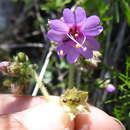Comprehensive Description
(
İngilizce
)
North American Flora tarafından sağlandı
Allionia comata Small, Fl. SB. U. S. 407. 1903
Oxybaphus nyctagineus Cervantesii A. Gray, in Torr. Bot. Mex. Bound. Surv. 174. 1859. Not
Calyxhymenia Cervantesii Desf. 1829. Oxybaphus nyctagineus oblongifolius A. Gray, in Torr. Bot. Mex. Bound. Surv. 174, in part. 1859. Oxybaphus viscosus Hemsl. Biol. Centr. Am, Bot. 3 : 3, in part. 1 882. Not 0. viscosus I/Her. 1849. Oxybaphus Cervantesii S. Wats. Proc. Am. Acad. 18: 142. 1883. Allionia nyctaginea Cervantesii Coult. Contr. U. S. Nat. Herb. 2: 352. 1894. Not A. Cervantesii
Steud. 1840. Mirabilis nyctaginea setigera Heimerl, Beitr. Syst. Nyct. 22. 1897. Mirabilis nyctaginea oblongifolia Heimerl, Beitr. Syst. Nyct. 23, in part. 1897. Mirabilis nyctaginea Cervantesii Heimerl, Beitr. Syst. Nyct. 23. 1897. Mirabilis nyctaginea alpicola Heimerl, Beitr. Syst. Nyct. 23. 1897. Allionia pratensis Standley, Contr. U. S. Nat. Herb. 12: 351. 1909. Allionia melanotricha Standley, Contr. U. S. Nat. Herb. 12: 351. 1909. Oxybaphus melanotrichus Weatherby, Proc. Am. Acad. 45: 425. 1910. Oxybaphus comatus Weatherby, Proc. Am. Acad. 49: 492. 1913. Oxybaphus pratensis Weatherby, Proc. Am. Acad. 49: 492. 1913.
Stems few or solitary, from a woody root, usually erect, sometimes decumbent, 3-12 dm. high, stout or slender, simple or sparsely branched below the inflorescence, sometimes with weak sterile branches at the base, green, or glaucescent below, glabrous below or bifariously puberulent, very rarely pilose with soft viscid fulvous hairs, pilose or short-pilose above but the pubescence usually bifarious below the inflorescence, the internodes usually elongate; petioles slender, 1-5 cm. long, glabrous or puberulent, rarely white-pilose in the earliest leaves; leaf-blades usually elongate-deltoid but sometimes deltoid, ovate, or lanceolate, 3-10 cm. long, 0.8-5.5 cm. wide, subcordate or truncate at the base or sometimes cordate, obtuse, or acutish, acute or attenuate at the apex or often obtuse, rarely rounded, entire or subundulate, thin, bright-green, sparsely viscid-puberulent or short-pilose or glabrous, commonly ciliolate; inflorescence cymose-paniculate, usually narrow and sparsely branched, sometimes broad and loosely branched, the branches slender, alternate, viscid-pilose with fulvous hairs, bearing very few bractlike leaves; involucres few or numerous, usually short-pedunculate, 3-5 mm. long at anthesis, about 8 mm. long in fruit, densely viscid-pilose with fulvous or often black hairs, the lobes oval-oblong, usually longer than the tube and rounded at the apex; perianth 10-12 mm. long, purplish-red, sparsely pilose, the limb sometimes 20 mm. broad; stamens 3-5, long-exserted ; fruit obovoid, 3-4.5 mm. long, brownishor blackish-olivaceous, minutely pilose, the angles broad, usually tuberculate, the sides coarsely or finely tuberculate; seed obovoid, 2-3 mm. long, brownish-stramineous.
Typ^ locality: New Mexico, probably about Santa Rita.
Distribution : Meadows and thickets in the mountains, Arizona to western Texas, southward to Sonora and Puebla.
- bibliyografik atıf
- Paul Carpenter Standley. 1918. (CHENOPODIALES); ALLIONIACEAE. North American flora. vol 21(3). New York Botanical Garden, New York, NY
Comprehensive Description
(
İngilizce
)
North American Flora tarafından sağlandı
Allionia comata Small, Fl. SE. U. S. 407. 1903
Oxybaphus nyctagineus Cervantesii A. Gray, in Torr. Bot. Mex. Bound. Surv. 174. 1859. Not
Calyxhymenia Cervantesii Desf. 1829. Oxybaphus nyctagineus oblongifolius A. Gray, in Torr. Bot. Mex. Bound. Surv. 174, in part. 1859. Oxybaphus viscosus Hemsl. Biol. Centr. Am. Bot. 3 : 3, in part. 1882. Not 0. viscosus I/Her. 1849. Oxybaphus Cervantesii S. Wats. Proc. Am. Acad. 18: 142. 1883.
Allionia nyclaginea Cervantesii Coult. Contr. U. S. Nat. Herb. 2: 352. 1894. Not ^4. Cervantesii
Steud. 1840. Mirabilis nyctaginea setigera Heimerl, Beitr. Syst. Nyct. 22. 1897. Mirabilis nyctaginea oblongifolia Heimerl, Beitr. Syst. Nyct. 23, in part. 1897. Mirabilis nyctaginea Cervantesii Heimerl, Beitr. Syst. Nyct. 23. 1897. Mirabilis nyctaginea alpicola Heimerl, Beitr. Syst. Nyct. 23. 1897. Allionia pratensis Standley, Contr. U. S. Nat. Herb. 12: 351. 1909. Allionia melanotricha Standley, Contr. U. S. Nat. Herb. 12: 351. 1909. Oxybaphus melanotrichus Weatherby, Proc. Am. Acad. 45: 425. 1910. Oxybaphus comatus Weatherby, Proc. Am. Acad. 49: 492. 1913. Oxybaphus pratensis Weatherby, Proc. Am. Acad. 49: 492. 1913.
Stems few or solitary, from a woody root, usually erect, sometimes decumbent, 3-12 dm. high, stout or slender, simple or sparsely branched below the inflorescence, sometimes with weak sterile branches at the base, green, or glaucescent below, glabrous below or bifariously puberulent, very rarely pilose with soft viscid fulvous hairs, pilose or short-pilose above but the pubescence usually bifarious below the inflorescence, the internodes usually elongate; petioles slender, 1-5 cm. long, glabrous or puberulent, rarely white-pilose in the earliest leaves; leaf -blades usually elongate-deltoid but sometimes deltoid, ovate, or lanceolate, 3-10 cm. long,
0.8-5.5 cm. wide, subcordate or truncate at the base or sometimes cordate, obtuse, or acutish, acute or attenuate at the apex or often obtuse, rarely rounded, entire or subundulate, thin, bright-green, sparsely viscid-puberulent or short-pilose or glabrous, commonly ciliolate; inflorescence cymose-paniculate, usually narrow and sparsely branched, sometimes broad and loosely branched, the branches slender, alternate, viscid-pilose with fulvous hairs, bearing very few bractlike leaves; involucres few or numerous, usually short-pedunculate, 3-5 mm. long at anthesis, about 8 mm. long in fruit, densely viscid-pilose with fulvous or often black hairs, the lobes oval-oblong, usually longer than the tube and rounded at the apex; perianth 10-12 mm. long, purplish-red, sparsely pilose, the limb sometimes 20 mm. broad; stamens 3-5, long-exserted ; fruit obovoid, 3-4.5 mm. long, brownishor blackish-olivaceous, minutely pilose, the angles broad, usually tuberculate, the sides coarsely or finely tuberculate; seed obovoid, 2-3 mm. long, brownish-stramineous.
Type locality : New Mexico, probably about Santa Rita.
Distribution: Meadows and thickets in the mountains, Arizona to western Texas, southward to Sonora and Puebla.
- bibliyografik atıf
- Paul Carpenter Standley. 1918. (CHENOPODIALES); ALLIONIACEAE. North American flora. vol 21(3). New York Botanical Garden, New York, NY

